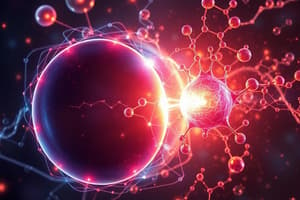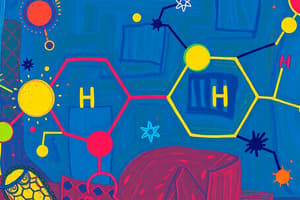Podcast
Questions and Answers
What does the VSEPR theory primarily help predict?
What does the VSEPR theory primarily help predict?
- The properties of ionic compounds
- The types of chemical reactions
- The shape of molecular structures (correct)
- The electronegativity of various elements
Which type of reaction is specifically characterized by the formation of a product from two or more reactants?
Which type of reaction is specifically characterized by the formation of a product from two or more reactants?
- Synthesis Reaction (correct)
- Decomposition Reaction
- Single Displacement Reaction
- Combustion Reaction
What is the primary feature of a net ionic equation?
What is the primary feature of a net ionic equation?
- It simplifies the total number of compounds involved
- It only shows the actual chemical species that participate in the reaction (correct)
- It includes all spectator ions
- It represents the total ionic strength of the solution
In which unit would you find a discussion about molar mass?
In which unit would you find a discussion about molar mass?
Which factor is not related to the rate of solubility of a substance in a solvent?
Which factor is not related to the rate of solubility of a substance in a solvent?
What concept does the ideal gas law directly relate to?
What concept does the ideal gas law directly relate to?
What is the significance of knowing the empirical formula of a compound?
What is the significance of knowing the empirical formula of a compound?
Which of the following correctly defines a hydrate?
Which of the following correctly defines a hydrate?
Flashcards
Decomposition Reaction
Decomposition Reaction
A type of chemical reaction where a single reactant breaks down into two or more products. Think of it as taking apart a puzzle.
Acid
Acid
A type of compound that releases hydrogen ions (H+) when dissolved in water. They have a sour taste and can react with bases to form salts and water.
Base
Base
A type of compound that releases hydroxide ions (OH-) when dissolved in water. They have a bitter taste and can react with acids to form salts and water.
Net Ionic Equation
Net Ionic Equation
Signup and view all the flashcards
Combustion Reaction
Combustion Reaction
Signup and view all the flashcards
Molar Mass
Molar Mass
Signup and view all the flashcards
Percentage Composition
Percentage Composition
Signup and view all the flashcards
Hydrate
Hydrate
Signup and view all the flashcards
Study Notes
Unit 1 - Chemical Reactions
- 1.2 Ionic Compounds Nomenclature: Covers the naming of ionic compounds.
- 1.3 Polyatomic Ions and Oxyanions: Details about polyatomic ions and oxyanions, including examples and naming conventions.
- 1.3 Acids and Bases: Information on acids and bases, their properties and classifications.
- 1.4 Writing and Balancing Chemical Equations: Methods for writing and balancing chemical equations to represent reactions accurately.
- 1.5 Synthesis and Decomposition Reactions: Explains synthesis and decomposition reactions.
- 1.6 Single and Double Displacement Reactions: Describes single and double displacement reactions.
- 1.7 Net Ionic Equations: How to write net ionic equations, highlighting the net reaction of ions.
- 1.8 Combustion Reactions: Details on combustion reactions and their general form.
Unit 2 - Chemical Structures, Trends, and Bonding
- Math Skills for Chemistry: Review of relevant mathematical concepts used in chemistry.
- 2.1 Atomic Theory: Fundamental aspects of atomic theory and structure.
- 2.2 Isotopic Abundance: Explores the concept of isotopes and their relative abundance.
- 2.3 Periodic Trends and Characteristics: Discusses trends in the periodic table and elements' characteristics.
- 2.4 Molecular Compounds: Information on molecular compounds.
- 2.5 Electronegativity and Bond Polarity: Details on electronegativity and bond polarity in molecules.
- 2.6 VSEPR Theory: Explores Valence Shell Electron Pair Repulsion theory (VSEPR) to predict molecular geometry.
- 2.7 Molecular Polarity: Explains factors contributing to molecular polarity.
- 2.8 Intermolecular Forces: Covers different types of intermolecular forces and their impact on substances' properties.
Unit 3 - The Mole and Avogadro's Constant
- 3.2 Molar Mass: Explains the concept of molar mass and its calculation.
- 3.3 The Mole Road: Describes using molar mass to determine the amount of substance.
- 3.4 Percentage Composition: Calculating percentage of each element in a compound.
- 3.5 Hydrates: Details about hydrate compounds and their formula determination.
- 3.6 Empirical Formula: Defining and calculating empirical formulas from experimental data.
- 3.7 Molecular Formula: Determination of molecular formulas from empirical formulas and molar masses.
- 3.8 Stoichiometry (Mole-Mole Ratios): Calculations involving mole ratios in chemical reactions.
- 3.9 Stoichiometry (Mole-Mass Ratios): Calculations using moles and mass in reactions.
- 3.10 Limiting and Excess Reagents: Identifying limiting and excess reactants in reactions.
- 3.11 Percentage Yield: Calculating the percentage yield of chemical products.
Unit 4 - Solutions & Solubility
- 4.1 Solutions and Solubility: Definition of solutions and factors influencing solubility.
- 4.2 Factors Affecting Solubility and Solubility Curve: Factors affecting solubility and graphical representations of solubility.
- 4.3 Concentrations of Solutions: Various methods for expressing solution concentrations.
- 4.4 Dilutions: Calculating concentrations after diluting a solution.
- 4.5 Solution Stoichiometry: Applying stoichiometric principles to solutions.
- 4.6 Acids, Bases, pH, and pOH: Properties of acids and bases and calculations involving pH and pOH.
Unit 5 - Gases and Atmospheric Chemistry
- Gas Laws: Fundamental gas laws and their applications.
- Ideal Gas Law and Gas Stoichiometry: The ideal gas law and its application to stoichiometric calculations involving gases.
- States of Matter and KMT: States of matter and Kinetic Molecular Theory (KMT).
Studying That Suits You
Use AI to generate personalized quizzes and flashcards to suit your learning preferences.




